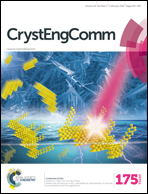The morphology and polymorphism of self-nucleated trigonal isotactic poly(1-butene) studied by synchrotron IR microspectroscopy†
Abstract
The self-nucleation behaviour of isotactic poly(1-butene) in the trigonal modification was investigated. Large and isolated Form I spherulites, successfully generated via a purposely designed thermal history protocol, were self-nucleated at different temperatures and subsequently crystallized at 90 °C. The morphology that developed was analysed using polarized optical microscopy, and the polymorphic content and distribution were monitored using synchrotron IR microspectroscopy. Images of the polymorphic distribution were generated using both univariate (band ratio) and multivariate (chemometric) analyses of the spectral data. From the morphological point of view, polarised optical microscopy showed that low seeding temperatures (<130 °C) enabled preservation of the original large spherulite that served as a seed for the growth of Form II at its periphery through cross-nucleation. However, with increasing seeding temperature, more complex morphologies arise, through progressive fading of the original morphology. Firstly, re-crystallization results in a defective large spherulite, and then at temperatures above 132 °C, it results in numerous highly-nucleated Form II spherulites. The IR microspectroscopy images generated either by univariate (band ratio) or multivariate (hierarchical cluster analysis) mappings provided concise information on the spatial distribution of the two polymorphs in the re-crystallized specimens, with a resolution in the range of several microns. It was shown that the content of Form II in the region of the self-nucleated Form I spherulite increases with increasing seeding temperature, demonstrating that the morphological changes accompany the gradual erosion of the memory of the original crystalline structure.


 Please wait while we load your content...
Please wait while we load your content...